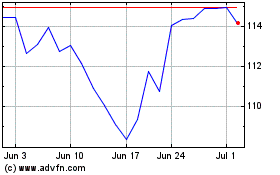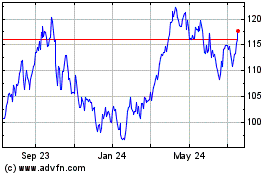Exxon's $20 Billion Spending Plan Points to U.S. Energy Surge
March 06 2017 - 4:45PM
Dow Jones News
By Bradley Olson
HOUSTON -- Exxon Mobil Corp. plans to spend about $20 billion on
refineries, petrochemical plants and other projects in and around
the Gulf of Mexico, Chief Executive Darren Woods said Monday,
underscoring how the giants of the global energy industry are
turning to America.
Mr. Woods outlined the 11-project spending plan, largely aimed
at creating new outlets for U.S. natural gas, in a speech at the
annual CERAWeek conference. It came after a meeting with analysts
last week in which he said Exxon is poised to nearly double its
production from U.S. shale basins in the next decade.
Chevron Corp. is expected to unveil similar plans this week,
ramping up its operations in the already booming Permian basin in
West Texas and New Mexico. The company's output from the region
could reach 900,000 barrels a day by 2020 if oil prices continue to
rise, according to energy investment bank Tudor Pickering Holt
& Co. That would mean production from one company in just one
area would rival output from major world producers such as
Azerbaijan.
Exxon's announcement underscored the extent to which new
technology has unlocked vast new resources in the U.S., upending
the balance of power in global oil. Even as the Organization of the
Petroleum Exporting Countries and other nations moved late last
year to put a floor under the oil price by cutting production, U.S.
operators have vowed to return to the oilfields almost en masse to
make up the difference.
"Hydraulic fracturing has opened up a whole new energy future
for the United States, and potentially for many other countries,"
Mr. Woods said Monday. "We have managed, in the United States, to
accomplish what was practically unthinkable only a decade ago."
The conference is expected to be defined by similar bravado as
energy titans from companies and governments gather, eager to show
off their resilience after prices fell from more than $100 in
mid-2014 to below $30 in February of last year before beginning a
partial recovery. Prices have been hovering steadily above $50 for
weeks.
In his remarks, Mr. Woods also praised industry efforts to
respond to the threat of climate change, spending much of his
high-profile address discussing what Exxon is doing to reduce
emissions. The remarks, as well as others he has made since taking
over as chief executive, such as expressing support for the 2015
Paris climate deal, have signaled the company's plan to stay the
course in its environmental stance.
That comes even as some in President Donald Trump's inner circle
have pushed to walk away from the deal, while others have urged Mr.
Trump to keep the country's part in the agreement.
"We have an opportunity to contribute and help mitigate that
risk through technology," Mr. Woods said.
He also extolled the virtues of free trade as having an
elemental role in the U.S. energy renaissance.
Global energy executives have shown mixed responses to plans by
U.S. Republicans to change tax policy in a way that would favor
exports and burden imports into the country.
"It's hard to be in our business and not support open markets
and free trade," he said.
The U.S. will be the greatest contributor to new global supply
through 2022, with production from shale rising to 1.4 million
barrels a day if prices remain around $60 a barrel, according to
the Paris-based International Energy Agency. If prices rise to $80,
output from shale fields alone could reach 3 million barrels a day,
about the same as Kuwait, the IEA said Monday.
Companies such as Exxon are making immense investments in their
refining, chemicals and export operations to take advantage of the
new opportunity. From 2010 to 2020, such investments are expected
to reach almost $180 billion, according to the American Chemistry
Council, about 70% of which will go to the U.S. Gulf Coast.
In addition to Exxon's plans to build new plants or expand
facilities to turn natural gas into the building blocks of common
plastics, companies including Royal Dutch Shell PLC, Chevron
Phillips Chemical and others plan similar investments or will
expand production of fertilizer, polymers used to make lubricants,
and even tennis racket strings.
Write to Bradley Olson at Bradley.Olson@wsj.com
(END) Dow Jones Newswires
March 06, 2017 16:30 ET (21:30 GMT)
Copyright (c) 2017 Dow Jones & Company, Inc.
Exxon Mobil (NYSE:XOM)
Historical Stock Chart
From Mar 2024 to Apr 2024

Exxon Mobil (NYSE:XOM)
Historical Stock Chart
From Apr 2023 to Apr 2024
